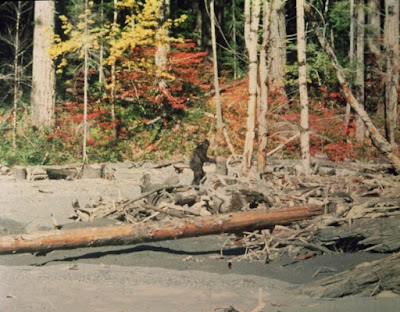 |
| PGF frame showing the true colors found there in October. |
How to Treat the PGF Film Site at Bluff Creek When Visiting: Keep in Mind, You are Walking on History.
Please see below for some of the things you really should avoid doing on the Film Site, if you care at all about Bigfoot and its history in Bluff Creek. Bluff Creek Project is currently working with the USFS and its new chairman, Merv George, to get the site declared an Historical Landmark.
Recall the red color behind the film subject, around the front and eastern side of the PGF site Big Tree? Those are vine maples, a lovely shrubby tree that goes from green in the summer, to pale yellowish-green in the fall, finally turning red when the cold of winter begins to set in come later October or November. These leaves are part of how we know that the film was not shot in August or September, as some claim. It shows a scene that is in correspondence with the story told by Patterson and Gimlin. Hence, these trees are evidence. When we finally located the PGF site, part of what verified it for us was the vine maples there in front of the signature Douglas fir, beside the broadleaf maple that provides the yellow color in the film. That latter maple is still there and growing, nearly fifty years later. In the same spot, the progeny of the PGF vine maples stood.
 |
| Senseless destruction of life and history. |
Above is the Big Tree as it stands today, also showing historic vine maple trees cut down by a certain noted Bigfoot researcher, destroying part of the evidence of the site. I counted at least 35 annual growth rings, making these trees the progeny of those seen in the PGF.
 |
| Our guests from Arkansas, supporters of the Bluff Creek Project, who came with us to the site last week. Here they are having a tough time getting through the downed vine maple branches. |
 |
| At least 35 years of growth, almost as old as the film itself. These grew from the same patch you see at the bottom of the Big Tree in the film. |
 |
| The Big Stump, to left of subject in Frame 352 et seq. |
 |
| The Tall, or "Smiley" Stump, to right of subject in Frame 352 et seq. Showing significant degradation from people leaning & sitting on it. |
 |
| Part of the debris pile behind which the subject walks after Frame 352, at the front of the current sandbar. |
 |
| Log pile seen in back and east of film subject. Showing significant degradation from people walking across the logs. |
 |
| Big Leaf Maple on the Site. |
The sandbar is eroding around its edges. Some is caused by the creek and weather, but a lot of it is due to humans walking around. Do note the established trail up to the top of it from the creek, and avoid climbing on its edges if you can. Every step takes another few inches away from history.
 |
| Natural erosion, caused by the creek, took down a major amount of sand and gravel at the crook in the creek near the first sighting spot. |
Also... Don't Litter. Here's a measurement two-by-four that someone left behind. If you're wondering about our colored survey flags, we're done with those, and we'll be doing a more professional survey this summer, so we'll be removing all old flagging currently on the site other than a few trail markers.
Patty's trackway, up to frame 352. We've cleared dead and low-hanging branches somewhat, but we avoid taking out living trees and shrubs. Don't conduct major excavations here, or remove large quantities of the sand on the historic sandbar. That fine dark grey silt sand you find just beneath the forest duff is what Patty walked upon. It was put there by the major 1964 Flood. It, too, is part of the history.
*
BLUFF CREEK PROJECT,
Technology in the Field. Low impact, high tech.
For your own safety, be bear-aware and keep an eye out for mountain lions. We are monitoring these with our camera project. Please do not harm them, either.
For your own safety, be bear-aware and keep an eye out for mountain lions. We are monitoring these with our camera project. Please do not harm them, either.
You can read all about the film site on this blog. Just put "Bluff Creek into the search box here... bigfootbooksblog.blogspot.com
Visit the new BLUFF CREEK PROJECT BLOG here: http://bluffcreekproject.blogspot.com/
Links to our YouTube page and the videos we've gotten of wildlife in the area and on the site are provided there.
 |
| The Big Tree today, a massive old-growth Douglas fir. |
*










